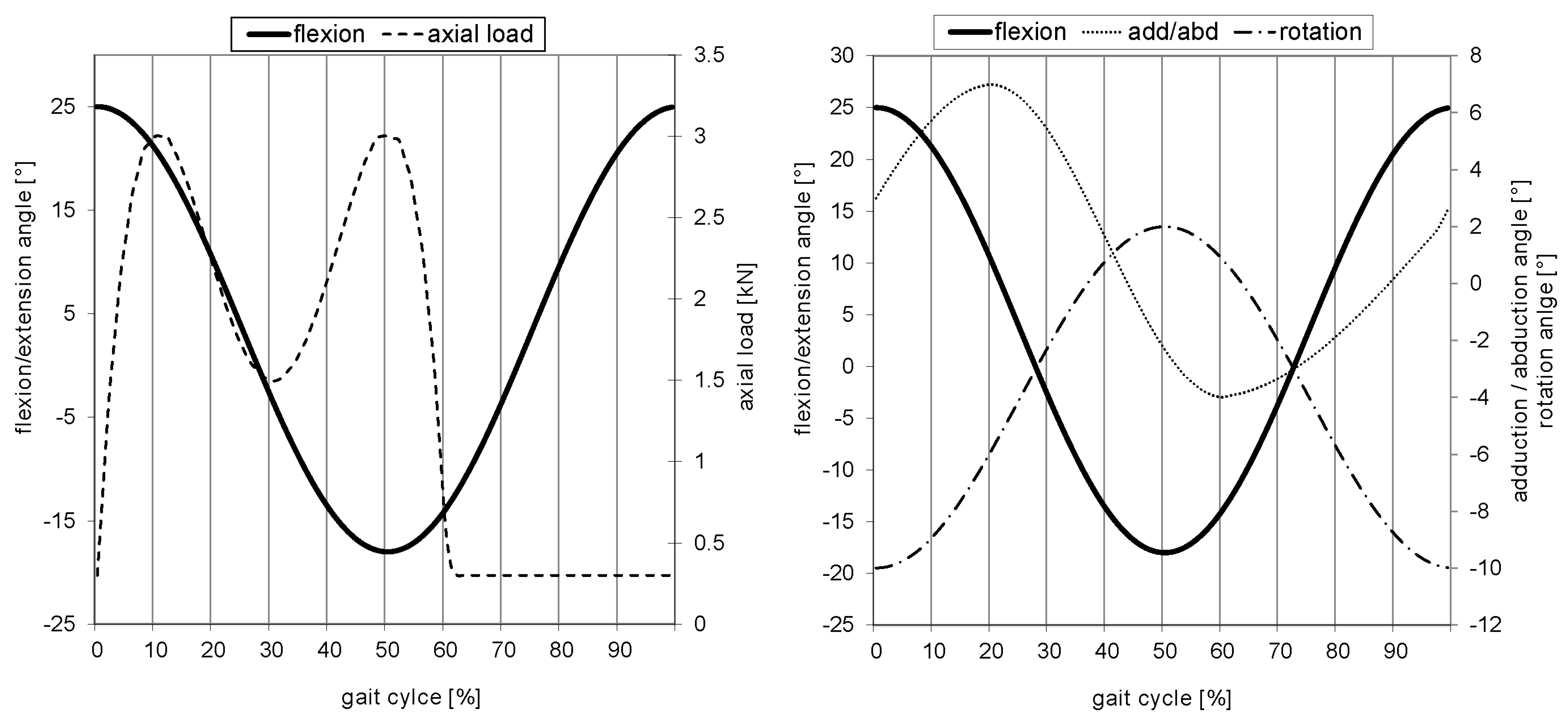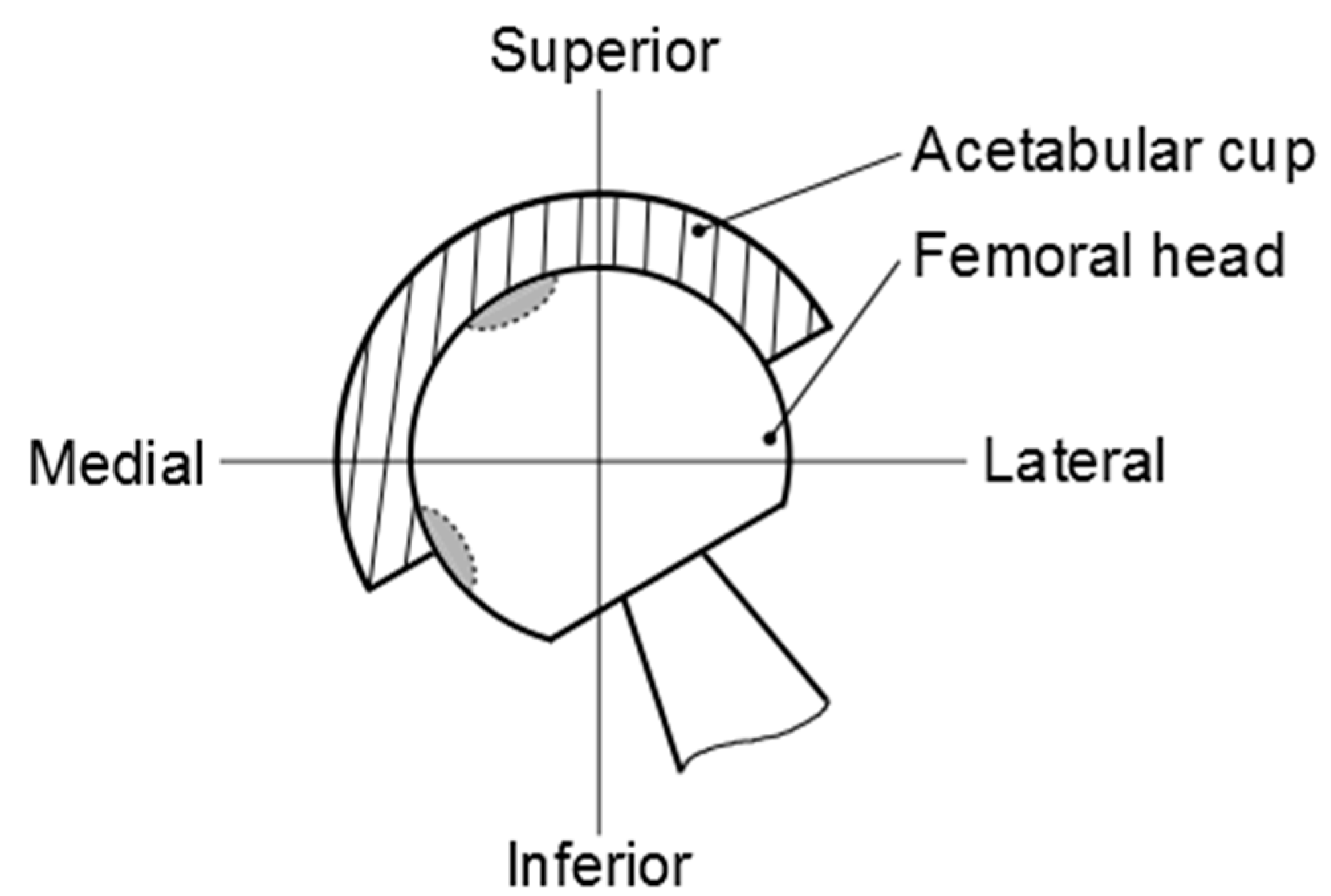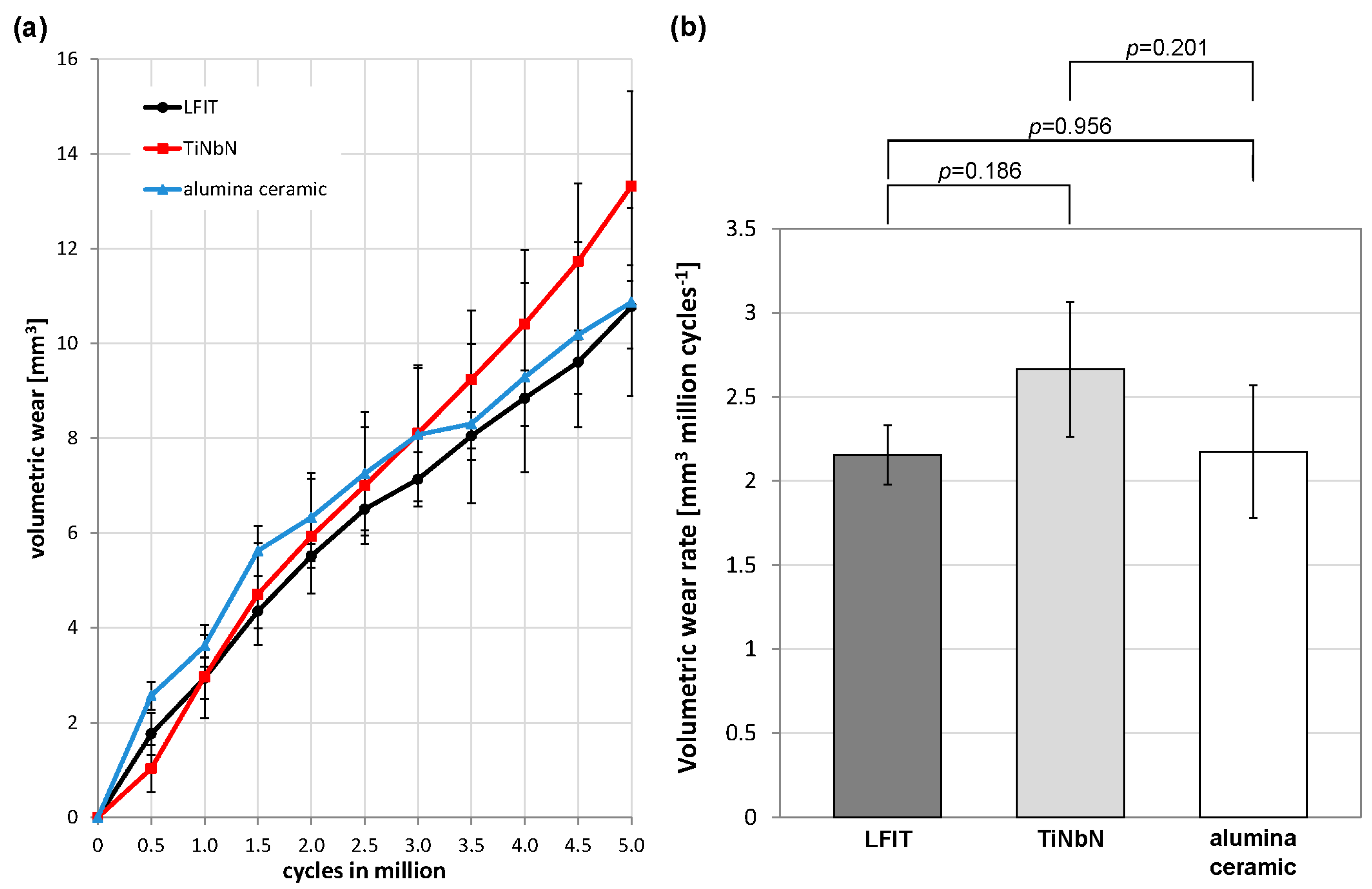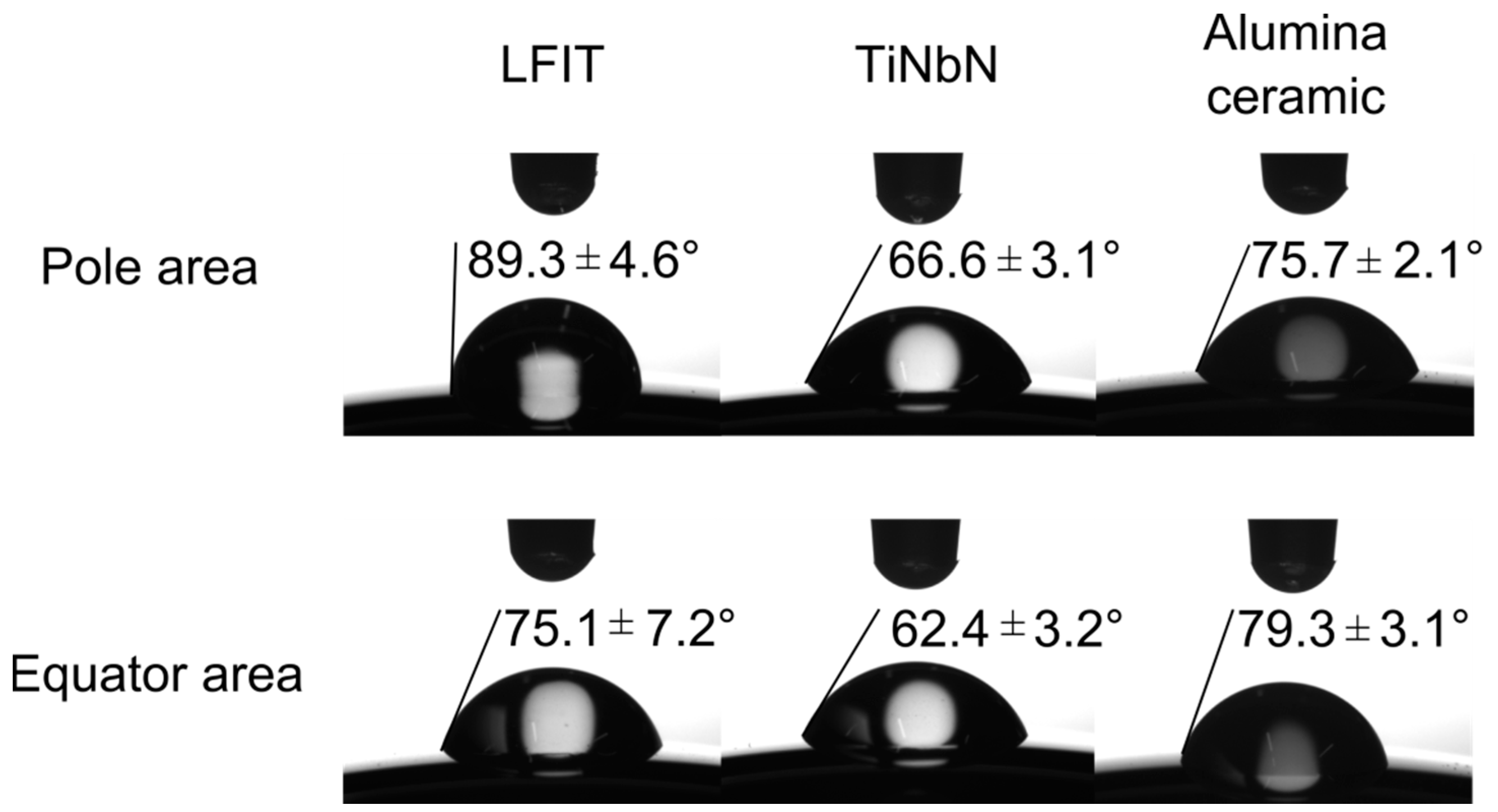Wear Performance of Sequentially Cross-Linked Polyethylene Inserts against Ion-Treated CoCr, TiNbN-Coated CoCr and Al2O3 Ceramic Femoral Heads for Total Hip Replacement
Abstract
:1. Introduction
2. Material and Methods
2.1. Test Specimens
2.2. Hip Simulator Wear Test

2.3. Contact Angle Measurements

2.4. Analysis of the Cobalt Ion Level
2.5. Statistical Analysis
3. Results
3.1. Wear Rates

3.2. Contact Angle Measurement

3.3. Cobalt Ion Concentration

4. Discussion
5. Conclusions
Acknowledgments
Author Contributions
Conflicts of Interest
References
- Affatato, S.; Bordini, B.; Fagnano, C.; Taddei, P.; Tinti, A.; Toni, A. Effects of the sterilisation method on the wear of UHMWPE acetabular cups tested in a hip joint simulator. Biomaterials 2002, 23, 1439–1446. [Google Scholar]
- Medel, F.J.; Kurtz, S.M.; Hozack, W.J.; Parvizi, J.; Purtill, J.J.; Sharkey, P.F.; MacDonald, D.; Kraay, M.J.; Goldberg, V.; Rimnac, C.M. Gamma inert sterilization: A solution to polyethylene oxidation? J. Bone Joint Surg. Am. 2009, 91A, 839–849. [Google Scholar]
- Galvin, A.; Kang, L.; Tipper, J.; Stone, M.; Ingham, E.; Jin, Z.; Fisher, J. Wear of crosslinked polyethylene under different tribological conditions. J. Mater. Sci. Mater. Med. 2006, 17, 235–243. [Google Scholar]
- Kilgour, A.; Elfick, A. Influence of crosslinked polyethylene structure on wear of joint replacements. Tribol. Int. 2009, 42, 1582–1594. [Google Scholar]
- Kurtz, S.M.; Gawel, H.A.; Patel, J.D. History and systematic review of wear and osteolysis outcomes for first-generation highly crosslinked polyethylene. Clin. Orthop. Relat. Res. 2011, 469, 2262–2277. [Google Scholar]
- Lerf, R.; Zurbrugg, D.; Delfosse, D. Use of vitamin E to protect cross-linked UHMWPE from oxidation. Biomaterials 2010, 31, 3643–3648. [Google Scholar]
- Oral, E.; Muratoglu, O.K. Vitamin E diffused, highly crosslinked UHMWPE: A review. Int. Orthop. 2011, 35, 215–223. [Google Scholar]
- Bracco, P.; Oral, E. Vitamin E-stabilized UHMWPE for total joint implants: A review. Clin. Orthop. Relat. Res. 2011, 469, 2286–2293. [Google Scholar]
- Eberhardt, A.W.; McKee, R.T.; Cuckler, J.M.; Peterson, D.W.; Beck, P.R.; Lemons, J.E. Surface roughness of CoCr and ZrO2 femoral heads with metal transfer: A retrieval and wear simulator study. Int. J. Biomater. 2009, 2009, 1–6. [Google Scholar]
- Dahl, J.; Soderlund, P.; Nivbrant, B.; Nordsletten, L.; Rohrl, S.M. Less wear with aluminium-oxide heads than cobalt-chrome heads with ultra high molecular weight cemented polyethylene cups: A ten-year follow-up with radiostereometry. Int. Orthop. 2012, 36, 485–490. [Google Scholar]
- Wang, S.J.; Zhang, S.D.; Zhao, Y.C. A comparison of polyethylene wear between cobalt-chrome ball heads and alumina ball heads after total hip arthroplasty: A 10-year follow-up. J. Orthop. Surg. Res. 2013, 8, 1–4. [Google Scholar]
- Urban, J.A.; Garvin, K.L.; Boese, C.K.; Bryson, L.; Pedersen, D.R.; Callaghan, J.J.; Miller, R.K. Ceramic-on-polyethylene bearing surfaces in total hip arthroplasty—Seventeen to twenty-one-year results. J. Bone Joint Surg. Am. 2001, 83A, 1688–1694. [Google Scholar]
- Gotman, I.; Hunter, G.; Gutmanas, E.Y. Wear resistant ceramic films and coatings. In Comprehensive Biomaterials; Ducheyne, P., Ed.; Elsevier Science: Amsterdam, The Netherlands, 2011; pp. 127–155. [Google Scholar]
- McGrory, B.J.; Ruterbories, J.M.; Pawar, V.D.; Thomas, R.K.; Salehi, A.B. Comparison of surface characteristics of retrieved cobalt-chromium femoral heads with and without ion implantation. J. Arthroplasty 2012, 27, 109–115. [Google Scholar]
- Bader, R.; Bergschmidt, P.; Fritsche, A.; Ansorge, S.; Thomas, P.; Mittelmeier, W. Alternative materials and solutions in total knee arthroplasty for patients with metal allergy. Orthopäde 2008, 37, 136–142. [Google Scholar]
- Harman, M.K.; Banks, S.A.; Hodge, W.A. Wear analysis of a retrieved hip implant with titanium nitride coating. J. Arthroplasty 1997, 12, 938–945. [Google Scholar]
- Raimondi, M.T.; Pietrabissa, R. The in vivo wear performance of prosthetic femoral heads with titanium nitride coating. Biomaterials 2000, 21, 907–913. [Google Scholar]
- Ries, M.D.; Pruitt, L. Effect of cross-linking on the microstructure and mechanical properties of utra-high molecular weight polyethylene. Clin. Orthop. Relat. Res. 2005, 440, 149–156. [Google Scholar]
- Zietz, C.; Fabry, C.; Middelborg, L.; Fulda, G.; Mittelmeier, W.; Bader, R. Wear testing and particle characterisation of sequentially crosslinked polyethylene acetabular liners using different femoral head sizes. J. Mater. Sci. Mater. Med. 2013, 24, 2057–2065. [Google Scholar]
- ISO 14242-1:2014. Implants for Surgery—Wear of Total Hip-Joint Prostheses—Part 1: Loading and Displacement Parameters for Wear-Testing Machines and Corresponding Environmental Conditions for Test; ISO: Genève, Suisse, 2014. [Google Scholar]
- Clohisy, J.C.; Calvert, G.; Tull, F.; McDonald, D.; Maloney, W.J. Reasons for revision hip surgery—A retrospective review. Clin. Orthop. Relat. Res. 2004, 429, 188–192. [Google Scholar]
- Ingham, E.; Fisher, J. The role of macrophages in osteolysis of total joint replacement. Biomaterials 2005, 26, 1271–1286. [Google Scholar]
- Abu-Amer, Y.; Darwech, I.; Clohisy, J.C. Aseptic loosening of total joint replacements: Mechanisms underlying osteolysis and potential therapies. Arthritis Res. Ther. 2007, 9, 1–7. [Google Scholar]
- Fisher, J.; Jennings, L.M.; Galvin, A. Wear of highly crosslinked polyethylene against cobalt chrome and ceramic femoral heads. In Bioceramics and Alternative Bearings in Joint Arthroplasty: 11th BIOLOX Symposium Proceedings; Benazzo, F., Falez, F., Dietrich, M., Eds.; Steinkopff Verlag: Darmstadt, Germany, 2006; pp. 185–188. [Google Scholar]
- Galvin, A.L.; Tipper, I.L.; Jennings, L.M.; Stone, M.H.; Jin, Z.M.; Ingham, E.; Fisher, J. Wear and biological activity of highly crosslinked polyethylene in the hip under low serum protein concentrations. Proc. Inst. Mech. Eng. H 2007, 221, 1–10. [Google Scholar]
- Galvin, A.L.; Jennings, L.M.; Tipper, J.L.; Ingham, E.; Fisher, J. Wear and creep of highly crosslinked polyethylene against cobalt chrome and ceramic femoral heads. Proc. Inst. Mech. Eng. H 2010, 224, 1175–1183. [Google Scholar]
- Bowsher, J.G.; Williams, P.A.; Clarke, I.C.; Green, D.D.; Donaldson, T.K. “Severe” wear challenge to 36 mm mechanically enhanced highly crosslinked polyethylene hip liners. J. Biomed. Mater. Res. B Appl. Biomater. 2008, 86B, 253–263. [Google Scholar]
- Galvin, A.; Brockett, C.; Williams, S.; Hatto, P.; Burton, A.; Isaac, G.; Stone, M.; Ingham, E.; Fisher, J. Comparison of wear of ultra-high molecular weight polyethylene acetabular cups against surface-engineered femoral heads. Proc. Inst. Mech. Eng. H 2008, 222, 1073–1080. [Google Scholar]
- Gutmanas, E.Y.; Gotman, I. PIRAC Ti nitride coated Ti-6Al-4V head against UHMWPE acetabular cup-hip wear simulator study. J. Mater. Sci. Mater. Med. 2004, 15, 327–330. [Google Scholar]
- Xin, Y.C.; Liu, C.L.; Huo, K.F.; Tang, G.Y.; Tian, X.B.; Chu, P.K. Corrosion behavior of ZrN/Zr coated biomedical AZ91 magnesium alloy. Surface Coat. Technol. 2009, 203, 2554–2557. [Google Scholar]
- Yuan, Y.; Lee, T.R. Contact Angle and Wetting Properties. In Surface Science Techniques; Bracco, G., Holst, B., Eds.; Springer: Heidelberg, Germany, 2013; pp. 3–34. [Google Scholar]
- Fabry, C.; Herrmann, S.; Kaehler, M.; Klinkenberg, E.D.; Woernle, C.; Bader, R. Generation of physiological parameter sets for hip joint motions and loads during daily life activities for application in wear simulators of the artificial hip joint. Med. Eng. Phys. 2013, 35, 131–139. [Google Scholar]
© 2015 by the authors; licensee MDPI, Basel, Switzerland. This article is an open access article distributed under the terms and conditions of the Creative Commons Attribution license (http://creativecommons.org/licenses/by/4.0/).
Share and Cite
Fabry, C.; Zietz, C.; Baumann, A.; Bader, R. Wear Performance of Sequentially Cross-Linked Polyethylene Inserts against Ion-Treated CoCr, TiNbN-Coated CoCr and Al2O3 Ceramic Femoral Heads for Total Hip Replacement. Lubricants 2015, 3, 14-26. https://doi.org/10.3390/lubricants3010014
Fabry C, Zietz C, Baumann A, Bader R. Wear Performance of Sequentially Cross-Linked Polyethylene Inserts against Ion-Treated CoCr, TiNbN-Coated CoCr and Al2O3 Ceramic Femoral Heads for Total Hip Replacement. Lubricants. 2015; 3(1):14-26. https://doi.org/10.3390/lubricants3010014
Chicago/Turabian StyleFabry, Christian, Carmen Zietz, Axel Baumann, and Rainer Bader. 2015. "Wear Performance of Sequentially Cross-Linked Polyethylene Inserts against Ion-Treated CoCr, TiNbN-Coated CoCr and Al2O3 Ceramic Femoral Heads for Total Hip Replacement" Lubricants 3, no. 1: 14-26. https://doi.org/10.3390/lubricants3010014




